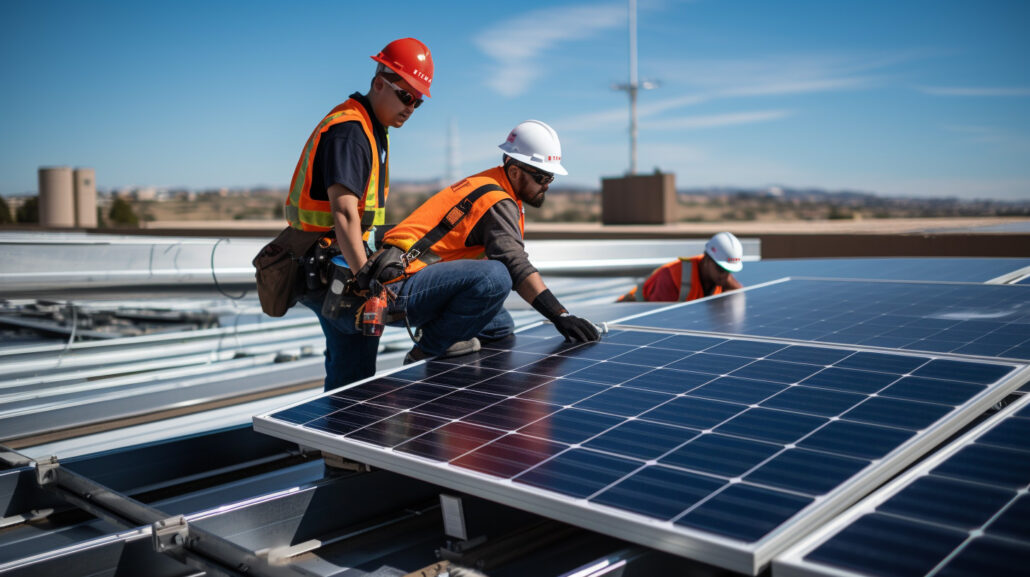
Image Source: Google
Solar energy is a sustainable and renewable source of power that is becoming increasingly popular among homeowners. The best Installing solar panels on your property not only helps reduce your electricity bills but also contributes to a greener environment. If you're a beginner looking to explore the world of the best solar panel installation, this guide is for you. We'll walk you through the essential steps and considerations to help you get started on your solar journey.
Step 1: Assess Your Property
Before diving into the installation process, it's crucial to assess your property to determine its suitability for solar panel installation. Here are some key factors to consider:
Factors to Consider:
- Available roof space: Ensure that your roof has enough space and is not obstructed by shading from trees or buildings.
- Roof orientation: South-facing roofs receive the most sunlight throughout the day, making them ideal for solar panel installation.
- Roof condition: Make sure your roof is in good condition and can support the weight of solar panels.
- Local regulations: Check with your local authorities regarding permits and regulations for installing solar panels in your area.
Step 2: Determine Your Energy Needs
Understanding your energy consumption patterns will help you determine the size of the solar panel system you need. Here's how you can estimate your energy needs:
Estimating Your Energy Needs:
- Review your electricity bills to determine your average monthly and annual energy consumption.
- Consider any changes in your energy usage that may occur in the future, such as adding new appliances or vehicles.
- Consult with a solar energy provider to help you calculate the size of the solar panel system required to meet your energy needs.
Step 3: Choose the Right Solar Panels
When selecting solar panels for your installation, there are several factors to consider to ensure you get the most efficient and cost-effective system:
Factors to Consider:
- Efficiency: Look for solar panels with high efficiency ratings to maximize energy production.
- Warranty: Check the warranty offered by the manufacturer to ensure the longevity and performance of the solar panels.
- Cost: Compare the upfront cost and long-term savings of different solar panel options to find the best value for your investment.
Step 4: Find a Solar Panel Installer
While some homeowners may opt for a DIY solar panel installation, hiring a professional installer can help ensure the job is done safely and efficiently. Here's how you can find a reputable solar panel installer:
Tips for Finding a Solar Panel Installer:
- Ask for recommendations from friends, family, or neighbors who have installed solar panels.
- Research online reviews and ratings of local solar panel installers.
- Get quotes from multiple installers to compare pricing and services.
- Verify the installer's credentials and certifications to ensure they meet industry standards.
Step 5: Prepare for Installation
Before the installation process begins, there are a few steps you can take to prepare your property for the arrival of the solar panel installer:
Preparation Tips:
- Clean your roof to remove any debris or dirt that may obstruct the installation process.
- Trim any overhanging branches or vegetation that could shade the solar panels.
- Clear a path for the installer to access the roof and other installation areas.
- Discuss the installation timeline and any specific requirements with the installer to ensure a smooth process.
Step 6: Install and Connect the Solar Panels
Once the preparation is complete, the installation process can begin. Here's an overview of what to expect during the installation and connection of your solar panels:
Installation Process:
- Mounting: The installer will secure the mounting system to your roof to support the solar panels.
- Wiring: The solar panels will be connected in a series and wired to an inverter to convert the DC electricity to AC electricity.
- Testing: The system will be tested to ensure it is generating electricity efficiently and safely.
- Connection: The solar panels will be connected to your electrical panel to start powering your home.
Step 7: Monitor and Maintain Your Solar Panel System
Once your solar panel system is up and running, it's essential to monitor its performance and conduct regular maintenance to ensure optimal efficiency. Here are some tips for maintaining your solar panel system:
Maintenance Tips:
- Monitor energy production regularly to identify any issues or drops in performance.
- Clean the solar panels periodically to remove dirt, dust, and debris that may affect their efficiency.
- Check the inverter for any error messages and ensure it is functioning correctly.
- Schedule annual inspections with a professional to assess the condition of your solar panel system.
Conclusion
Installing solar panels on your property is a rewarding investment that offers long-term benefits for both your wallet and the environment. By following this ultimate guide for beginners, you'll be well-equipped to navigate the solar panel installation process with confidence and success. Start harnessing the power of the sun today and make a positive impact on your energy consumption and the planet.
